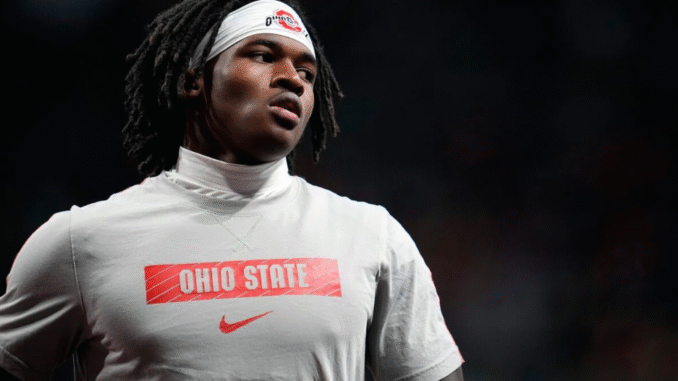
Players are now being paid directly by schools through revenue sharing. Like it or not, if you support a school, part of its net revenue is going to compensate its athletes—thanks to the House v. NCAA settlement. But what happens when a player’s individual marketing rights clash with their school’s commercial deals? Could a star athlete like Jeremiah Smith disrupt a major revenue stream?
Take Ohio State, for example. It’s a Nike school under a 15-year agreement signed in 2018, valued at $252 million. About $112 million of that is in Nike gear, with the rest in cash—roughly $16.8 million per year in total. That money supports all Ohio State athletic programs, from uniforms to coaching gear.
So the question is: Could Jeremiah Smith be the athlete who challenges the foundation of school apparel contracts?

Is Jeremiah Smith the First to Challenge School Apparel Contracts?
Jeremiah Smith is arguably the best wide receiver in college football—and he’s only a sophomore. The Ohio State standout finished his freshman season with 76 catches for 1,315 yards and 15 touchdowns, ranking fourth nationally in receiving yards and third in touchdowns in 2024.
Now, as he enters his second year with the Buckeyes, Smith has become more than just a rising star on the field. He’s also a paid endorser for Adidas—a direct rival of Ohio State’s official sponsor, Nike.
Clash of the Brands?
Smith’s Name, Image, and Likeness (NIL) deal with Adidas is a private agreement, so the terms haven’t been disclosed. But it’s safe to assume the arrangement involves wearing Adidas products—be it headbands, wristbands, or even appearing in Adidas marketing campaigns.
Here’s the tension: Ohio State’s contract with Nike is one of the most lucrative in college sports. Signed in 2018, the 15-year deal is worth $252 million—about $112 million in product and $140 million in cash. That breaks down to roughly $16.8 million annually, supporting everything from football uniforms to volleyball knee pads.
The Nike deal requires that all Ohio State athletes wear Nike gear during competition and in any official media involving the school. So what happens if Jeremiah Smith takes off his helmet during a nationally televised game and reveals an Adidas-branded bandana? Is that a violation of Ohio State’s contract—or a rightful expression of his personal endorsement deal?
A Legal Collision Course
This isn’t just a branding issue—it’s a financial one. The money from apparel deals like Ohio State’s with Nike goes directly into the school’s net revenue, which now includes the new $20.3 million set aside annually for athlete compensation under the House v. NCAA settlement. Apparel deals, TV contracts, post-season revenue, and ticket sales all factor into that bottom line.
So when a player signs a deal that potentially jeopardizes a school’s corporate contract, it’s more than a PR headache—it could become a legal and financial challenge.
Historically, the NCAA tried to place guardrails around these scenarios. Early NIL guidance post-O’Bannon stated that athletes couldn’t wear or promote a competing brand in a way that involved school logos or official team gear. But today, the NCAA has minimal enforcement power and even less appetite to return to court—where it has lost repeatedly on NIL-related issues.
The Bigger Question
Does Smith’s Adidas deal directly violate Ohio State’s Nike agreement? That may depend on the details of both contracts—particularly how Nike defines exclusivity and how Adidas expects Smith to fulfill his endorsement obligations.
It’s entirely possible that something as seemingly small as a wristband or a t-shirt could spark the next big NIL-related lawsuit. And with the increasing number of athletes signing individual deals that may not align with their schools’ sponsors, it’s only a matter of time before someone forces the issue into the courts.
Smith is also believed to have NIL deals with Nintendo, Lululemon, and Red Bull—none of which appear to conflict with Ohio State’s corporate interests. But Adidas? That’s different.
So the question remains:
Is Jeremiah Smith the one who will break the unspoken truce between school contracts and player endorsements? Or is he just the first visible crack in a system that’s already straining under its own weight?

Leave a Reply